Happy winter solstice everyone.
Did anyone notice? While we have a few days until the solstice, we have passed the mid point in December. I do remember that the next two weeks will go quickly. January and a new year will soon be here. It is almost time to plant seeds. In addition the days will get longer. More daylight- Yes.
Here in Iowa City we have avoided the very cold weather...so far. It is coming. It is coming soon. Winter will officially be here in a few days. The forcast says no more above-freezing temperatures for a while.
Last weekend I was able to do some yard work. It will be a while before I resume that never-ending task. The bulb companies keep advertizing that you can still get and plant discount bulbs. They say it is not too late to plant. I think it is now too late.
Being cold in December is the way it is supposed to be.
We had another nice rain earlier this week. We have now had over an inch for the month. Because the ground was not frozen, it all sunk in. That is good. We will finish the year with a eight inch deficit. (Normal is about 35 inches.)
The Contest
Last week in the contest we had a very close vote. In fact with that last vote on Saturday, there was a tie. The cowinners were the bluebell and the hoya. Both will advance to the next round in just 9 weeks.
Here is the final totals:
This week will be Week #4
#1 Winter Aconite March 19, 2022
When I think of an early spring I think of winter aconite. Eranthis hymalis is the formal name. It emerges as a close second to the snowdrop as the first signs of spring.
I have more winter aconite in my garden than any other plant. Let me think about that rather bold statment. I know there are thousands of what are little bulbs. The only other possibility would be the scilla, aka squill.
Beverly Nichols, the British garden writer from a century ago, wrote about aconite. He said that there was no point to aconite, unless you grew them by the thousands. I will try to find that book, Down the Garden Path, to be more precise in my reference. (Many of our books are behind big plants on stools at the moment.) You really ought to meet Beverly Nichols if you do not know him already.
Two years ago, taking Nichols' advice, I planted almost a thousand aconite. I planted them in the front sidewalk bed. There is a video in the bonus section of those bulbs when they came up in 2021.
Aconite are in the buttercup family. As is the case for most of that family, they are poisonous. If you think about it that makes sense. Anything that blooms early could not taste good, or it would never have made it to today. There would be a fine line between just not tasting good, and being poisonous.
#2 Red tulip April 30, 2022
I do not know the name of this tulip. It was supposed to be Monsella, perhaps Julia's favorite tulip. (Do you have a favorite tulip?) But it wasn't Monsella. As a substitute it performed well. Tulips should be grown in clumps. The clump in this case was in the parkway near the elm tree. It is a tasty plant, so its display was a testament to the deer repellant I put on it when it was just emerging.
#3 Pale blue Siberian Iris May 20, 2022
I liked the composition of this picture. It has the flower in the midst of all that vertical green.
I was given this lovely little iris probably 25 years ago. Plants that were gifts are special. You develope a garden of memories of those people.
This particular iris has moved around the garden over time. I do now understand that iris clumps should be moved every 5-10 years.
#4 Kousa dogwood blossoms June 16, 2022
We have been adding dogwood trees along Fairview Avenue the last 5 years. They are replacing the pink crabapple trees that have been dying of old age. (Apparently some trees have defined life expectancies.) Most of the new dogwoods are Kousas. They bloom later and have white flowers. This is in contrast with the wonderful pink dogwood tree at the southwest corner of the house. That tree must be 30 years old at this point. It is doing fine.
#5 Pink orchid cactus June 18, 2022
Here is one of about a dozen big plants in the garden. I like growing these plants as not very many people grow them in Iowa. It is an orchid cactus.
Orchid cactus go well in the shade garden. All you have to do is hang them in the trees. These plants, in the genus epiphyllum, are relatives of the Christmas cactus most of us know. They have large flowers that bloom in the early summer.
I liked this picture as it shows the wonderful inner workings of this flower, the pistils and the stamen. (The stamen carry the pollen.)
We first met these plants in a now-closed nursery near Chincoteague, Virginia. It must have been in the 90's. I bought a small one and brought it home under my seat in the airplane. I then called the nursery which did not normally do mail order. They explained that they would have to charge postage. As I was alright with that, they mailed me another half dozen plants.
The plants like semi-shade. They were epiphytes at least at one time. That means they grow on another plant but are not parasitic. Orchids and bromiliads are also epiphytes.
They are tropical. That means that they have to come inside during the big cold part of the year. You then throw them outside when the danger of frost is over. However... and there often is a however, they need to have protection from the direct sun, particularly in the afternoon. That means they can go outside when the leaves have come out on the trees. Sometimes that can take a long time, with particular trees. The walnut tree and the sycamore tree are both quite late to get their leaves.
Did I mention that they are big? Well they are.
Surfing the internet for orchid cactus or epiphyllum can be quite rewarding. Look at this site.
https://gardenerspath.com/plants/succulents/best-epiphyllum-types/
Bonus pictures
Aconite
I really do equate acocnite with spring. I think that is why you now get many pictures of aconite.
Here is the video showing the front bed where I planted close to a 1000 aconite in the fall of 2020. The video is from the spring of 2021.
These next two pictures were from February 26, 2022. A lttle bit of warm weather in February yielded the first snowdrops and the first aconite. These were both on the south side of the house, which is a microclimate that is several weeks earlier than, for example, the front yard.
Enjoy other aconite pictures.
 |
| March 12, 2022 |
This is the backyard, where this is perhaps the earliest part of the garden.
 |
| March 17, 2022 |
In this closer view you can see the several generations of aconite. The newest plants are not yet big enough to bloom.
 |
| March 18, 2022 |
You can see that better in this picture.
 |
| March 20, 2022 |
After several years you almost have an aconite mat.
 |
| March 26, 2022 |
This is the raised bed by the back driveway. You can see how some plants jumped the bed into the path. Those volunteers can either get moved to a place in the garden without aconite or put in little pots for sale.
 |
| April 1, 2022 |
The aconite does begin to overlap with the scilla.
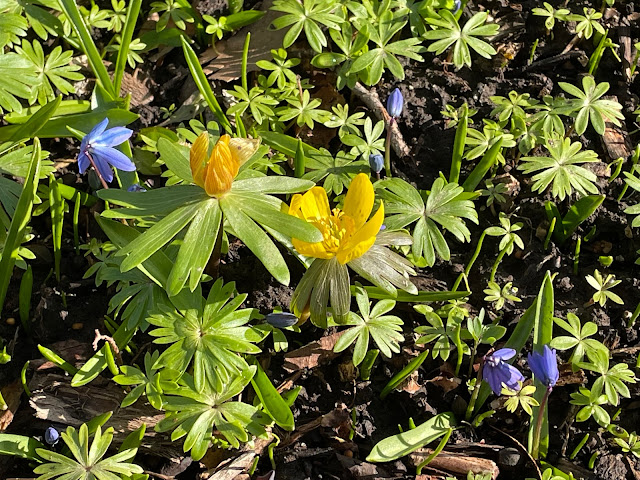 |
| April 2, 2022 |
This picture was from almost ten years ago. A late snow provided a striking background for the little yellow globes. The flowers do close up at night, forming little round things that look like tiny lightbulbs. They want the sun in order to open.
BEST ALL TIME ACONITE PICTURE
This picture was taken on March 6, 2021. That was when Katie, Elisabeth, Maisie and Christopher (in the picture) came to live with us for two months, fleeing COVID. I was so pleased Christopher could be here when spring arrived.
Other bonus pictures
Here is the clump of these red tulips. As they are hybrids they will not do well the second year. I planted Monsella tulips in their place for 2023. While deer would find them tasty, the spray worked well on this clump.
The blue in the background is from bluebells.
Here is the pink dogwood.
 |
| May 13, 2022 |
This dogwood flower, like the one in the contest is not complex. But quite nice.
Here is the clump for the iris in the contest this week.
Here is the kousa in bloom. It bloomed about a month after the pink dogwood.
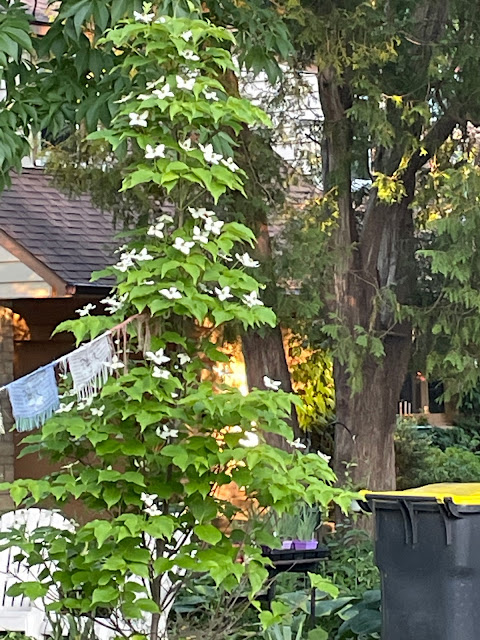 |
| June 10, 2022 |
This is the bud for the contestant #5. It opens in the evening. It is fully open by 10-11pm. Unlike its counsin, the Queen of the Night, it will stay open for the following day.

This picture is the picture of the full flower, that is contestant #5. I had the difficult job of picking which to include in the contest. At the last minute I chose the closeup.
Right now
Here is a little small cattleya-like orchid. It reliably blooms this time of year.
The kale continues. The negative temperatures next weekend might be the end. This is one I got from Pesche's (in Des Plaines, Illinois, when we were in the area to attend my sister's art exhibit and visit Julia's family) in early October.
This is a Lowe's discarded kale.
One plant I have not been able to grow is the hardy cyclamen. I try a few every few years. Sometimes they last a year or so. We all have to have continuing challeges. So far so good for this little one planted maybe 2 years ago.
I showed you this next picture last week. It is a
Dracaena fragrans. It is also known as the corn plant. (It is not really a corn plant.) We have had the plant for more than ten years. Just about two years ago exactly it bloomed for the first time. As it was December that event was indoors. Let me just say that it is not called 'fragrans' for nothing. I think it was the best smelling plant I have ever had indoors. Think oriental lilies.
 |
| December 10, 2022 |
 |
| December 17, 2022 |
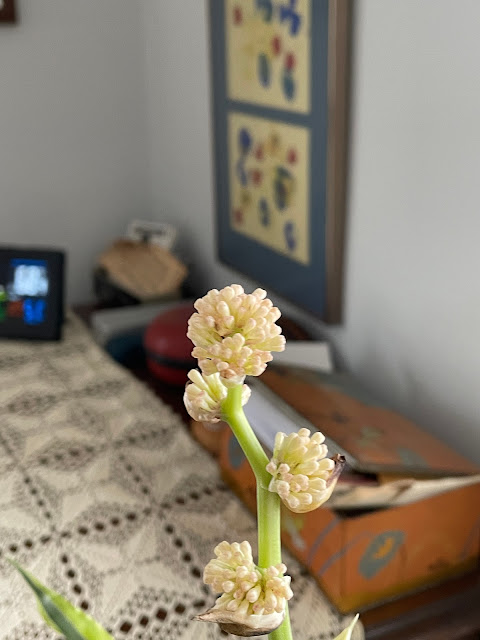 |
| December 17, 2022 |
The poor fall crocuses are just going to come up short. They have struggled to bloom for the last several weeks, as temperatures stayed above freezing. The difficulty is that they need above freezing temperatures and sun. Mostly in December when it is warm it is overcast. When it is sunny it is cold.
So no crocus bloom. They di get an A for effort.
Julia's recipe
Potatoes Anna, sort of
Potatoes Anna is a kind of casserole of soft and crispy potatoes that gets baked in a hot oven and then turned out onto a platter. This receipe is a variation - using some potatoes and also sweet potatoes and golden beets, which appeared in the November issue of Better Homes and Gardens.
The ingredients:
1-1/2 lbs. russet potatoes (2 largish);
3/4 lbs. sweet potato (1 largish);
1 lb. golden beets (3 medium);
1 stick of butter;
about 1-1/2 teaspoons smushed garlic;
some kosher salt and black pepper and
some green things to garnish - I had parsley; the recipe recommended chives.
You will need a heavy 10" skillet. I had castiron; any oven-safe skillet would do. You do want a pan with a handle.
I started by peeling everything. One of the beets was pale yellow. No matter. I did not use red beets because red beets stain everything they touch, and so using red beets would have muddied the colors in the dish in an unappealing way.
Next I turned the oven on to 425 degrees and put the stick of butter in a sauce pan. I cooked the butter (keeping an eye on it) until it was kind of tan. While it was cooking, I smushed the garlic. When the butter had browned, I added the garlic and took it off the heat.
With the browned butter and garlic on a trivet, I turned my attention to the vegetables. I sliced everything into rounds, aiming to keep them all at about 1/4" or less.
Assembly.
I brushed about 2 teaspoons of the garlic butter on the bottom of the skillet. Then I arranged a layer of potato and sweet potato and beet slices all around, starting from the outside and working in, overlapping the slices slightly.
Then I brushed about 1/3 of the remaining garlic butter on that first layer and sprinkled about 1/2
teaspoon of salt and 1/4 teaspoon of pepper over that.
I made two more layers, repeating the with garlic butter and salt and pepper after each one.
I did not have equal numbers of potato, sweet potato and beet slices, so the pattern changed on the last layer. No big deal, especially because the top layer in the skillet would turn out to be the bottom layer on the platter.
Here is the skillet, all full of vegetables with the last of the browned butter and salt and pepper on top.

When all of the vegetables were in, I sprayed no-stick spray on a piece of foil, clamped it on the skillet and put the skillet on the stove. I turned the heat to medium high and stood by. The idea was to heat the skillet until it sizzled before putting it in the hot oven.
A little video (with sound!) of the skillet sizzling.
I baked the skillet (with the foil on) for 30 minutes. Then I took the foil off and baked it for another 20-25 minutes, until a knife met no resistance when inserted into the vegetables.
I took the pan out (carefully, remembering that it was hot!) and let it sit for about 10 minutes. Near the end of that time, I ran a paring knife around the outside of the skillet in case there had been any sticking.
No sticking.
I flipped the skillet onto a platter and scattered some chopped parsley around.
It was good, especially if you like potatoes and sweet potatoes and beets, which we do. We had it with salmon (a go-to protein) simply prepared with a coating of a little mayo and a little dijon mustard mixed together. I did not fix another vegetable, but we did have a nice green salad.
Cold potatoes are, of course, good right out of the refrigerator or heated up.
This dish took a little time from start to finish, but most of the time was in the oven. Apparently one could use parsnips in addition to beets or instead. I have no relationship with parsnips, so I will stick to the trio of potatoes and sweet potatoes and golden beets. Parsnip fanciers should feel free to include them.
Odds and Ends
I sometimes see stories of interest during the week. This story in the Times on Wednesday talked about a yard I would like. It also had a happy ending, unless you count the money spent on lawyers. As a lawyer, I have mixed feelings about that part.
https://www.nytimes.com/2022/12/14/climate/native-plants-lawns-homeowners.html
The living room at the moment is all moved around as we go in our very late search for a Christmas tree. The crotons who have lived there for two months have temporary lodging elsewhere.
There is another winter farmer's market today in Iowa City. They happen 2 times a month during the winter. It will be another opportunity to get an African violet. Next week I will talk to you about wicking. We have always killed African violets, after a few months. Wicking seems to be a way to reliably water them without much thought.
Another week is done.
Pray for peace, and reconiliation. You are not obligated to save the world. You are only obligated to keep trying.
Philip














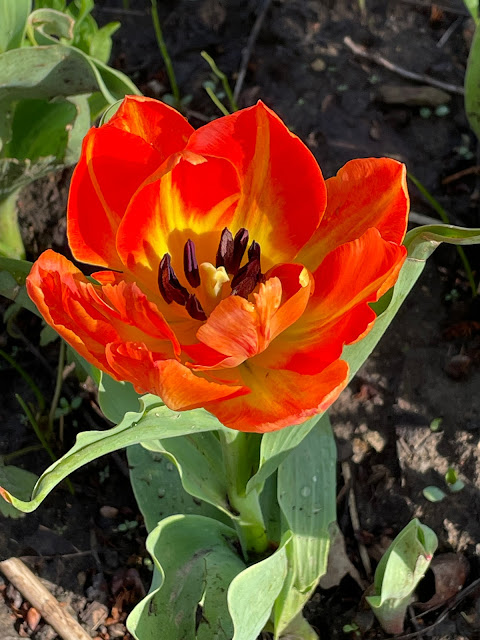










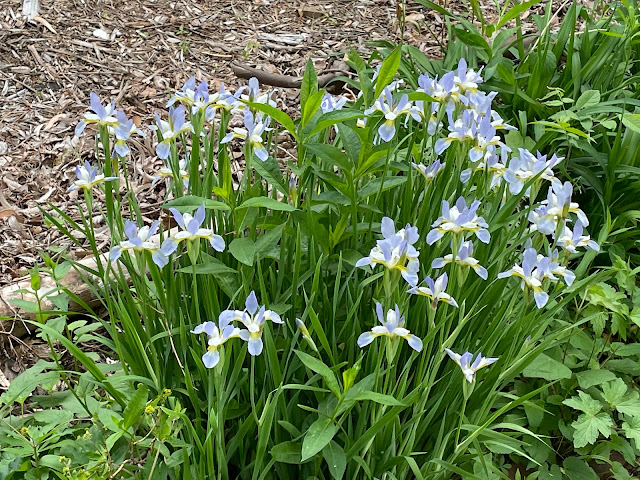















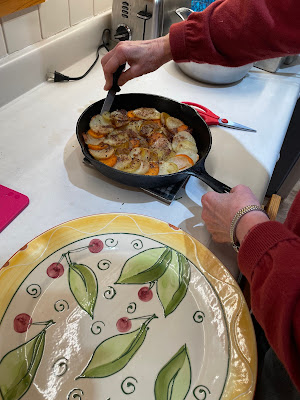

6 comments:
#5 Pink Orchid Cactus :^)
Good to hear from you Peter. I voted for the aconite, mostly because of that whole spring thing.
Julia’s joins the avant garde. Who else would think of making a video dedicated to aluminum foil sizzling?
DF
Love that sizzling video! Also love the aconite--I chose that picture over the more conventionally pretty ones, as a tribute to the fearlessness and general chutzpah of this great little flower.
It's good to see the dogwoods, both white and pink, on the blog. What a great flowering tree. You can have the magnolias and crepe myrtles--give me a dogwood any day.
We use to make potatoes anna--a slightly cheesy version--until we realized the massive calorie content. Your recipe sounds absolutely delicious.
And if you haven't tried parsnips, you should. Very tasty! They're a wonderful autumn-winter roasting vegetable, great alongside carrots, potatoes, sweet potatoes, and whatever else (brussls sprouts?) you like to roast in a pan with a little olive oil.
Watching your video of the aconite made memories flood to my senses! I could smell and hear the cool, damp, sunny air of the spring! I cannot wait :-)
Cami
I really should look at old videos from the garden. With sound they do add that dimension. I think about the sound of the wind in the last week.
I have to wonder what videos will be like in ten years. Will they ever be able to add smell?
Post a Comment